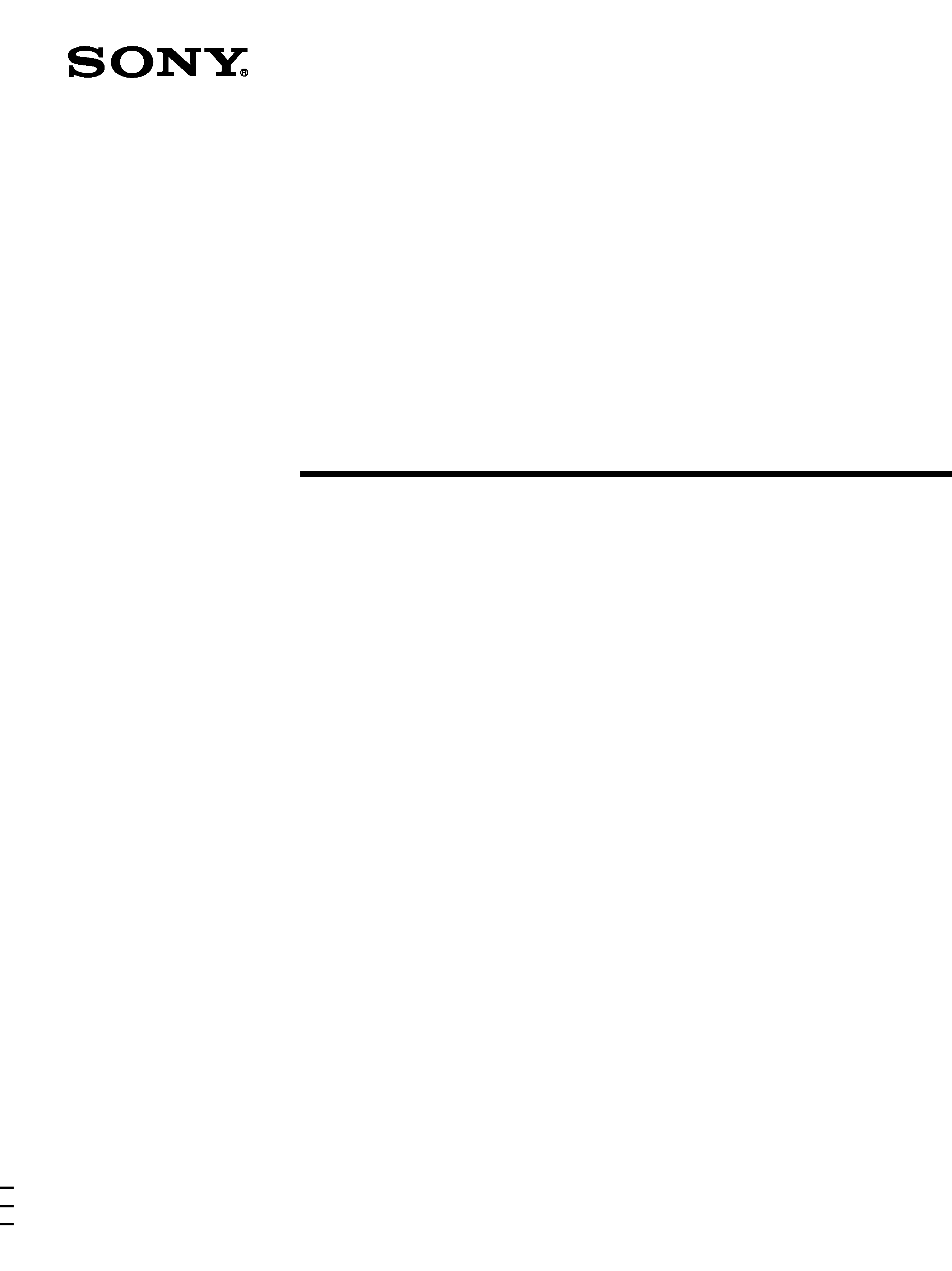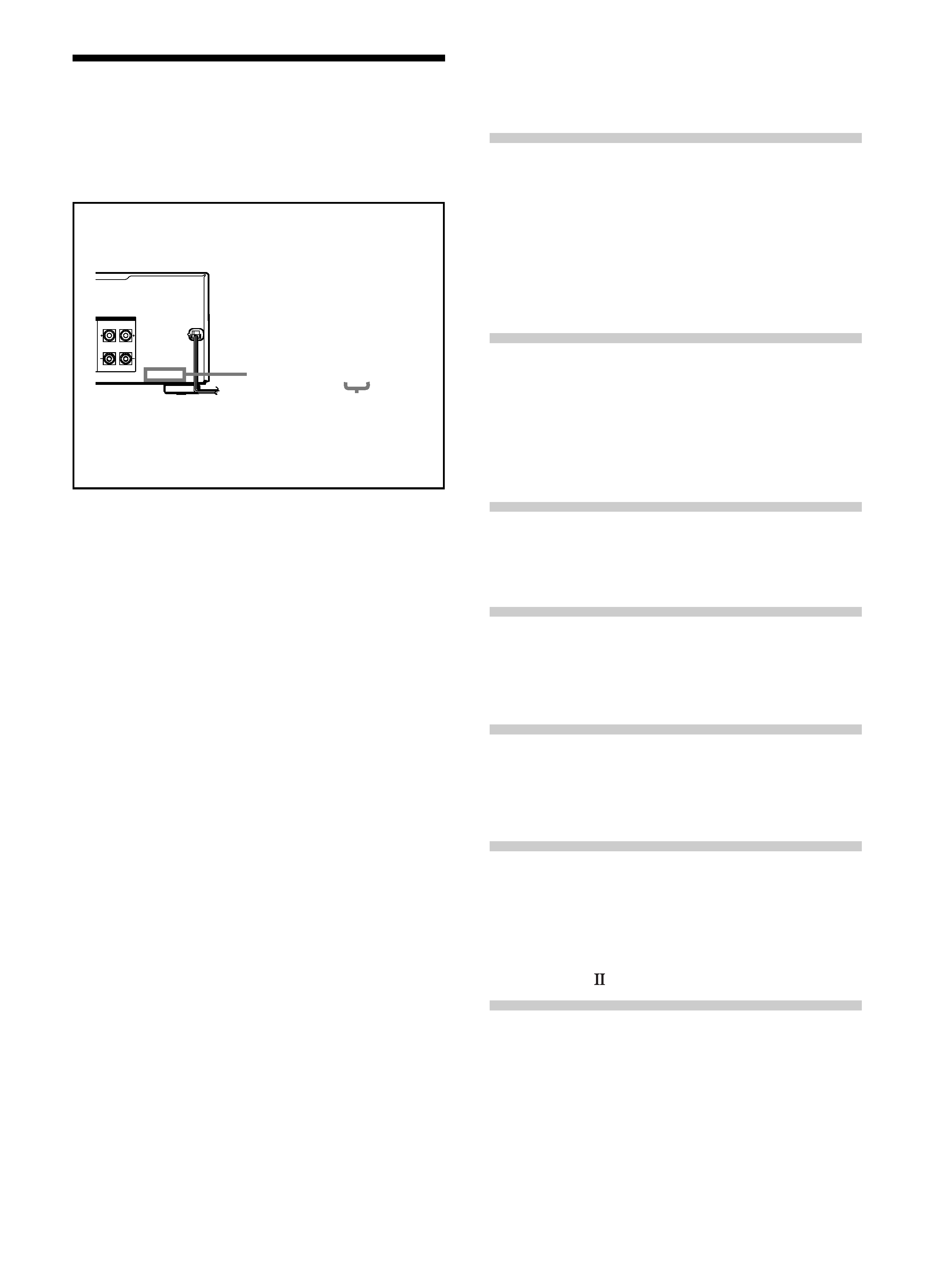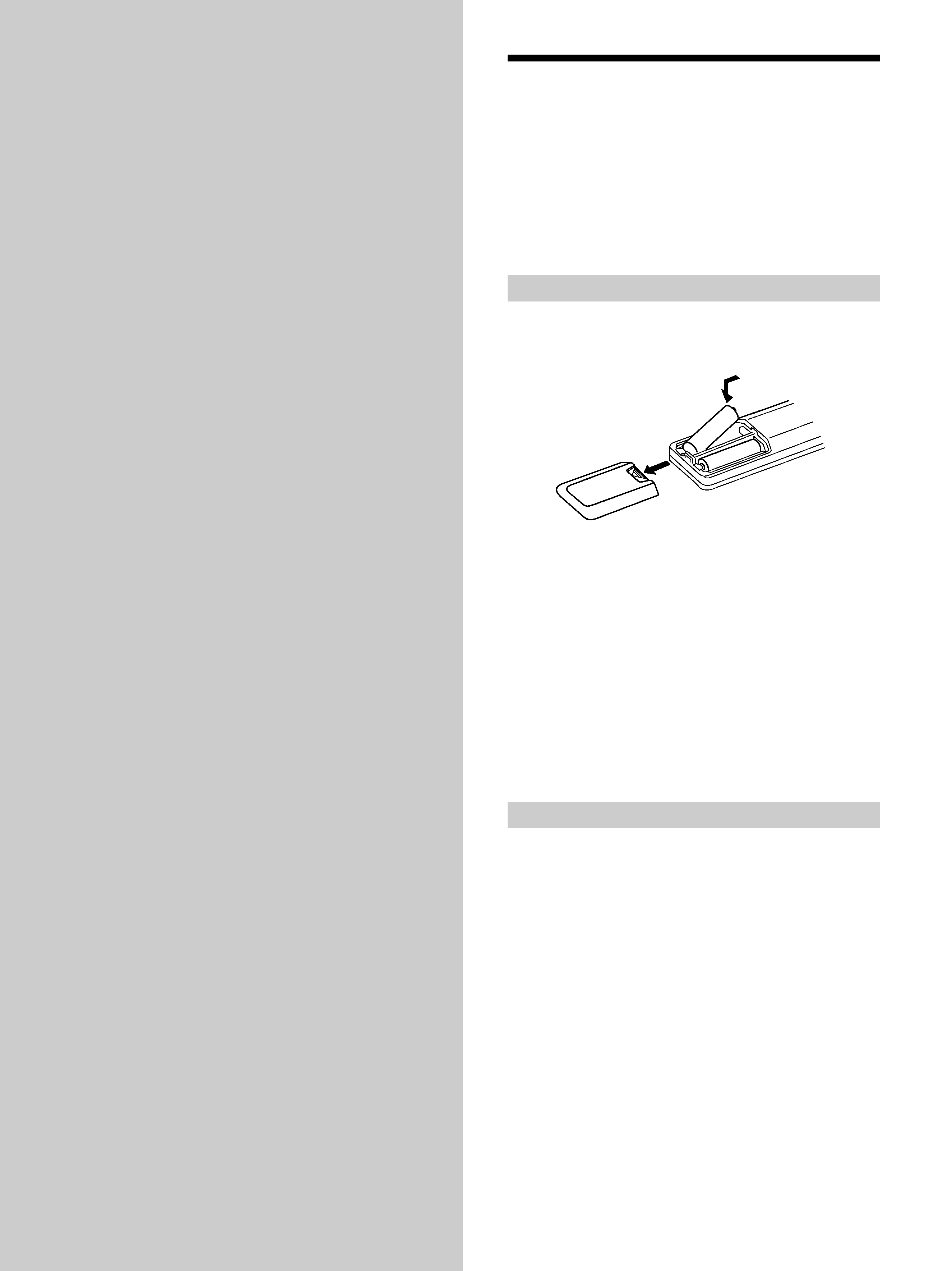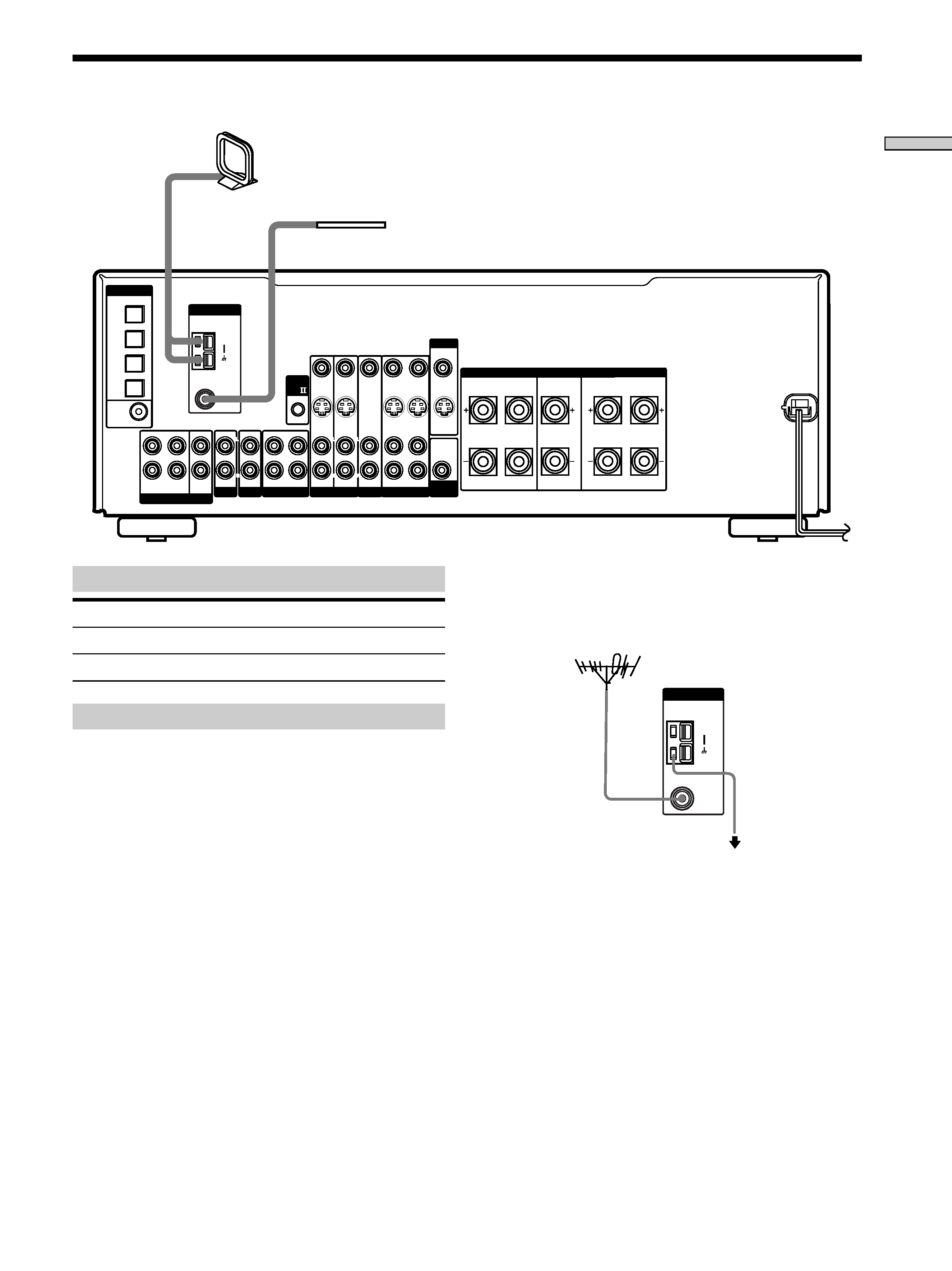
4-233-598-33(4)
FM Stereo
FM-AM Receiver
Operating Instructions
2001 Sony Corporation
STR-DE675

2
Precautions
On safety
· Should any solid object or liquid fall into
the cabinet, unplug the receiver and
have it checked by qualified personnel
before operating it any further.
· To prevent fire, do not cover the
ventilation of the receiver with
newspapers, table cloths, curtains, etc.
And don't place lighted candles on the
receiver.
· To prevent fire or shock hazards, do not
place vases on the receiver.
On power sources
· Before operating the receiver, check that
the operating voltage is identical with
your local power supply. The operating
voltage is indicated on the nameplate at
the rear of the receiver.
· The unit is not disconnected from the AC
power source (mains) as long as it is
connected to the wall outlet, even if the
unit itself has been turned off.
· If you are not going to use the receiver
for a long time, be sure to disconnect the
receiver from the wall outlet. To
disconnect the AC power cord, grasp the
plug itself; never pull the cord.
· AC power cord must be changed only at
the qualified service shop.
On placement
· Place the receiver in a location with
adequate ventilation to prevent heat
buildup and prolong the life of the
receiver.
· Do not place the receiver near heat
sources, or in a place subject to direct
sunlight, excessive dust or mechanical
shock.
· Do not place anything on top of the
cabinet that might block the ventilation
holes and cause malfunctions.
· Although the receiver heats up during
operation, this is not a malfunction. If
you continuously use this receiver at a
large volume, the cabinet temperature of
the top, side and bottom rises
accordingly. To avoid burning yourself,
do not touch the cabinet.
On operation
Before connecting other componeÆts, be
sure to turn off and unplug the receiver.
On cleaning
Clean the cabinet, panel and controls with
a soft cloth slightly moistened with a mild
detergent solution. Do not use any type of
abrasive pad, scouring powder or solvent
such as alcohol or benzine.
If you have any question or problem
concerning your receiver, please
consult your nearest Sony dealer.
WARNING
To prevent fire or shock
hazard, do not expose the
unit to rain or moisture.
To avoid electrical shock,
do not open the cabinet.
Refer servicing to qualified
personnel only.
Do not install the
appliance in a confined
space, such as a bookcase
or built-in cabinet.
Don't throw a battery,
dispose it as the injurious
wastes.

3
About This Manual
The instructions in this manual is for model STR-DE675.
Check your model number by looking at the lower right
corner of the front panel.
About area codes
The area code of the player you purchased is shown on the
lower portion of the rear panel (see the illustration below).
Any differences in operation, according to the area code, are
clearly indicated in the text, for example, "Models of area
code AA only".
Conventions
· The instructions in this manual describe the controls on
the receiver. You can also use the controls on the
supplied remote if they have the same or similar names
as those on the receiver.
· The following icon is used in this manual:
z
Indicates hints and tips for making the task easier.
This receiver incorporates Dolby* Digital and Pro Logic
Surround and the DTS** Digital Surround System.
* Manufactured under license from Dolby Laboratories.
"Dolby", "Pro Logic" and the double-D symbol a are trademarks of
Dolby Laboratories.
Confidential unpublished Works. © 1992-1997 Dolby Laboratories.
All rights reserved.
**Manufactured under license from Digital Theater Systems, Inc. US
Pat. No. 5,451,942, 5,956,674, 5,974,380, 5,978,762 and other
world-wide patents issued and pending. "DTS" and "DTS Digital
Surround" are registered trademarks of Digital Theater Systems, Inc.
Copyright 1996, 2000 Digital Theater Systems, Inc. All Rights
Reserved.
CENTER
FRONT
R
L
R
L
RS
IMPEDANCE USE 8 16
4-XXX-XXX-XX AA
Area code
TABLE OF CONTENTS
Hooking Up the Components
4
Unpacking 4
Antenna Hookups 5
Audio Component Hookups 6
Video Component Hookups 7
Digital Component Hookups 8
MULTI CH IN Hookups 10
Other Hookups
11
Hooking Up and Setting Up the
Speaker System
13
Speaker System Hookup
14
Performing Initial Setup Operations 16
Multi Channel Surround Setup 17
Before You Use Your Receiver 21
Location of Parts and Basic
Operations
23
Front Panel Parts Descriptions
23
Enjoying Surround Sound
27
Selecting a Sound Field
28
Understanding the Multi-Channel Surround Displays 32
Customizing Sound Fields
34
Receiving Broadcasts
38
Direct Tuning 40
Automatic Tuning 40
Preset Tuning 41
Other Operations
42
Naming Preset Stations and Program Sources 43
Recording 43
Using the Sleep Timer 44
Adjustment Using the SET UP Button
45
CONTROL A1
Control System
45
Additional Information
47
Troubleshooting
47
Specifications
49
Glossary 51
Settings Using SURR, LEVEL, EQ, and SET UP buttons 52
Remote Button Description
53
Index
Back cover

4
Hooking Up
the
Components
This chapter describes how to connect
various audio and video components
to the receiver. Be sure to read the
sections for the components you have
before you actually connect them to
the receiver.
Unpacking
Check that you received the following items with the
receiver:
· FM wire antenna (1)
· AM loop antenna (1)
· R6 (size-AA) batteries (2)
· Remote Commander (remote) (1)
Inserting batteries into the remote
Insert R6 (size-AA) batteries with the + and properly
oriented in the battery compartment. When using the
remote, point it at the remote sensor g on the receiver.
z When to replace batteries
Under normal conditions, the batteries should last for about 6
months. When the remote no longer operates the receiver, replace
all batteries with new ones.
Notes
· Do not leave the remote in an extremely hot or humid place.
· Do not use a new battery with an old one.
· Do not expose the remote sensor to direct sunlight or lighting
apparatuses. Doing so may cause a malfunction.
· If you don't use the remote for an extended period of time,
remove the batteries to avoid possible damage from battery
leakage and corrosion.
Before you get started
· Turn off the power to all components before making
any connections.
· Do not connect the AC power cords until all of the
connections are completed.
· Be sure to make connections firmly to avoid hum and
noise.
· When connecting an audio/video cord, be sure to
match the color-coded pins to the appropriate jacks on
the components: yellow (video) to yellow; white (left,
audio) to white; and red (right, audio) to red.
]
]
}
}

5
Hooking
Up
the
Components
FM wire antenna
(supplied)
AM loop antenna
(supplied)
Important
If you connect the receiver to an outdoor antenna, ground
it against lightning. To prevent a gas explosion, do not
connect the ground wire to a gas pipe.
Terminals for connecting the antennas
Connect the
To the
AM loop antenna
AM terminals
FM wire antenna
FM 75
COAXIAL terminal
Antenna Hookups
Notes on antenna hookups
· To prevent noise pickup, keep the AM loop antenna
away from the receiver and other components.
· Be sure to fully extend the FM wire antenna.
· After connecting the FM wire antenna, keep it as
horizontal as possible.
Ground wire
(not supplied)
To ground
z If you have poor FM reception
Use a 75-ohm coaxial cable (not supplied) to connect the receiver
to an outdoor FM antenna as shown below.
Outdoor FM antenna
DIGITAL
MD/
TAPE
OUT
MD/
TAPE
IN
TV/SAT
IN
DVD/LD
IN
OPTICAL
DVD/LD
IN
COAXIAL
SUB
WOOFER
MULTI CH IN
FRONT
SURROUND
SURROUND
CENTER
FRONT
R
L
CENTER
IN
AUDIO IN
AUDIO IN
S VIDEO
IN
VIDEO IN
VIDEO IN
VIDEO IN
VIDEO OUT
VIDEO OUT
VIDEO IN
S VIDEO
IN
S VIDEO
OUT
S VIDEO
IN
S VIDEO
OUT
AUDIO IN
AUDIO IN
AUDIO OUT
OUT
IN
IN
AUDIO
OUT
ANTENNA
AM
SUB
WOOFER
R
L
R
L
R
R
L
L
R
L
R
L
R
L
R
L
R
L
MD/TAPE
AUX
CD
TV/SAT DVD/LD VIDEO 2
MONITOR
CTRL
A1
VIDEO 1
SPEAKERS
IMPEDANCE USE 8 16
FM
75
COAXIAL
ANTENNA
AM
FM
75
COAXIAL
Receiver
